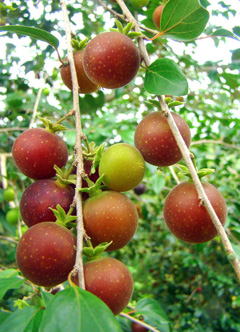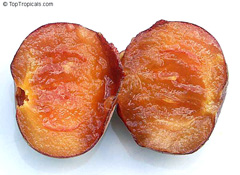 |
|
https://edibleplants.org/ |
 |
| https://edibleplants.org/ |
Translate this page:
Summary
Dovyalis abyssinica or commonly known as Abyssinian Gooseberry is an evergreen, dioecious, spiny shrub or small tree with a rounded crown. It reaches about 6-10 m in height with trunk diameter of about 20 cm. It can be found in highland forests in Eastern Africa. The leaves are oval and slender, with wavy or jagged edges. The edible fruit is small, round, and orange in colour. It has a thin, tender skin and a juicy flesh. Roots and stems can as well be eaten in tonic soup. The wood is hard and suitable for tool handles, spoons, and bedsteads. It can also be used for fuel. Abyssinian gooseberry can be grown by seed or cuttings.
Physical Characteristics

 Dovyalis abyssinica is an evergreen Shrub growing to 6 m (19ft) by 6 m (19ft) at a medium rate.
Dovyalis abyssinica is an evergreen Shrub growing to 6 m (19ft) by 6 m (19ft) at a medium rate.
See above for USDA hardiness. It is hardy to UK zone 10. The plant is not self-fertile.
Suitable for: light (sandy), medium (loamy) and heavy (clay) soils and prefers well-drained soil. Suitable pH: mildly acid and neutral soils and can grow in very acid soils.
It cannot grow in the shade. It prefers moist soil.
UK Hardiness Map
US Hardiness Map
Synonyms
Aberia abyssinica (A.Rich.) Clos Dovyalis engleri Gilg Flacourtia obtusata Hochst. ex A.Rich. Hydnoc
Plant Habitats
Edible Uses
Edible Parts: Fruit Root Stem
Edible Uses:
Fruit - raw or cooked[ 398 ]. The fruit has a thin, tender skin and a juicy melting flesh with an aroma and flavour faintly suggestive of apricots[ 301 ]. When fully ripe it makes a very agreeable jelly[ 301 ]. The fruit is about 25mm in diameter[ 200 ]. Roots and stems are eaten in a tonic soup[ 301 ].
References More on Edible Uses
Medicinal Uses
Plants For A Future can not take any responsibility for any adverse effects from the use of plants. Always seek advice from a professional before using a plant medicinally.
The leaves are pounded, soaked in water and the liquid taken as a treatment for indigestion[ 398 ]. The roots are used for treating indigestion and VD[ 398 ].
References More on Medicinal Uses
The Bookshop: Edible Plant Books
Our Latest books on Perennial Plants For Food Forests and Permaculture Gardens in paperback or digital formats.

Edible Tropical Plants
Food Forest Plants for Hotter Conditions: 250+ Plants For Tropical Food Forests & Permaculture Gardens.
More

Edible Temperate Plants
Plants for Your Food Forest: 500 Plants for Temperate Food Forests & Permaculture Gardens.
More

More Books
PFAF have eight books available in paperback and digital formats. Browse the shop for more information.
Shop Now
Other Uses
Fuel Wood
Other Uses: The wood is hard. It is used for tool handles, spoons and bedsteads[ 398 ]. The wood is used for fuel[ 398 ].
Special Uses
References More on Other Uses
Cultivation details
A plant of the hot, dry, tropics, though it also succeeds in areas of higher rainfall[ 335 ]. Grows best in a fertile, humus-rich, well-drained soil[ 200 ]. Dislikes calcareous soils[ 335 ]. Plants begin bearing when about 4 - 5 years old from seed[ 200 ]. Dioecious - both male and female plants must be grown if fruit is required. One male is sufficient for about 30 female plants[ 200 ].
References Carbon Farming Information and Carbon Sequestration Information
Temperature Converter
Type a value in the Celsius field to convert the value to Fahrenheit:
Fahrenheit:
The PFAF Bookshop
Plants For A Future have a number of books available in paperback and digital form. Book titles include Edible Plants, Edible Perennials, Edible Trees,Edible Shrubs, Woodland Gardening, and Temperate Food Forest Plants. Our new book is Food Forest Plants For Hotter Conditions (Tropical and Sub-Tropical).
Shop Now
Plant Propagation
Seed - Layering[ 200 ]. Graft or shield-bud desirable varieties on to seedling rootstocks[ 200 ].
Other Names
If available other names are mentioned here
Abyssinian gooseberry, Akudho, Ankakute, Gibin, Kimukiet, Kinokuet, Koshim, Koshum, Kudah, Limoro, Mahhahhari, Mbuchi, Mmango, Mnzuyuyu, Msambwa, Muirungi, Mukambura, Mundariwa, Mundililwa, Nokok, Nukchat, Ol-morogi, Ongolatz, Sangana, Songla, Songola,
Native Range
AFRICA: Ethiopia, Somalia, Yemen (Arkhabil Suqutrá), Kenya, Tanzania, Uganda, Malawi
Weed Potential
Right plant wrong place. We are currently updating this section.
Please note that a plant may be invasive in one area but may not in your area so it's worth checking.
Conservation Status
IUCN Red List of Threatened Plants Status : This taxon has not yet been assessed.

Growth: S = slow M = medium F = fast. Soil: L = light (sandy) M = medium H = heavy (clay). pH: A = acid N = neutral B = basic (alkaline). Shade: F = full shade S = semi-shade N = no shade. Moisture: D = dry M = Moist We = wet Wa = water.
Now available:
Food Forest Plants for Mediterranean Conditions
350+ Perennial Plants For Mediterranean and Drier Food Forests and Permaculture Gardens.
[Paperback and eBook]
This is the third in Plants For A Future's series of plant guides for food forests tailored to
specific climate zones. Following volumes on temperate and tropical ecosystems, this book focuses
on species suited to Mediterranean conditions—regions with hot, dry summers and cool, wet winters,
often facing the added challenge of climate change.
Read More
Expert comment
Author
(A.Rich.) Warb.
Botanical References
Links / References
For a list of references used on this page please go here
A special thanks to Ken Fern for some of the information used on this page.
Readers comment
| Add a comment |
|
If you have important information about this plant that may help other users please add a comment or link below. Only comments or links that are felt to be directly relevant to a plant will be included. If you think a comment/link or information contained on this page is inaccurate or misleading we would welcome your feedback at [email protected]. If you have questions about a plant please use the Forum on this website as we do not have the resources to answer questions ourselves.
* Please note: the comments by website users are not necessarily those held by PFAF and may give misleading or inaccurate information.
To leave a comment please Register or login here All comments need to be approved so will not appear immediately.
|
Subject : Dovyalis abyssinica
|
|
|
|